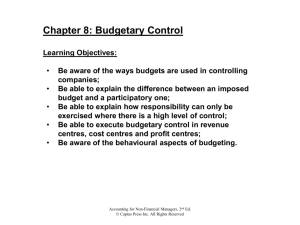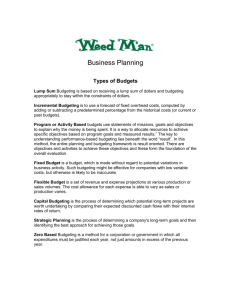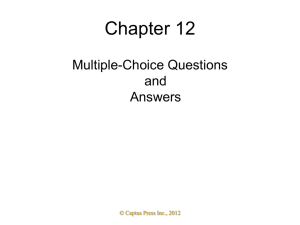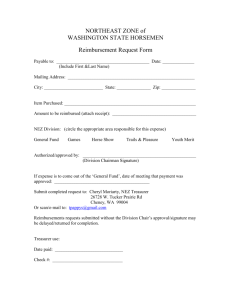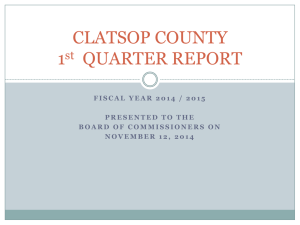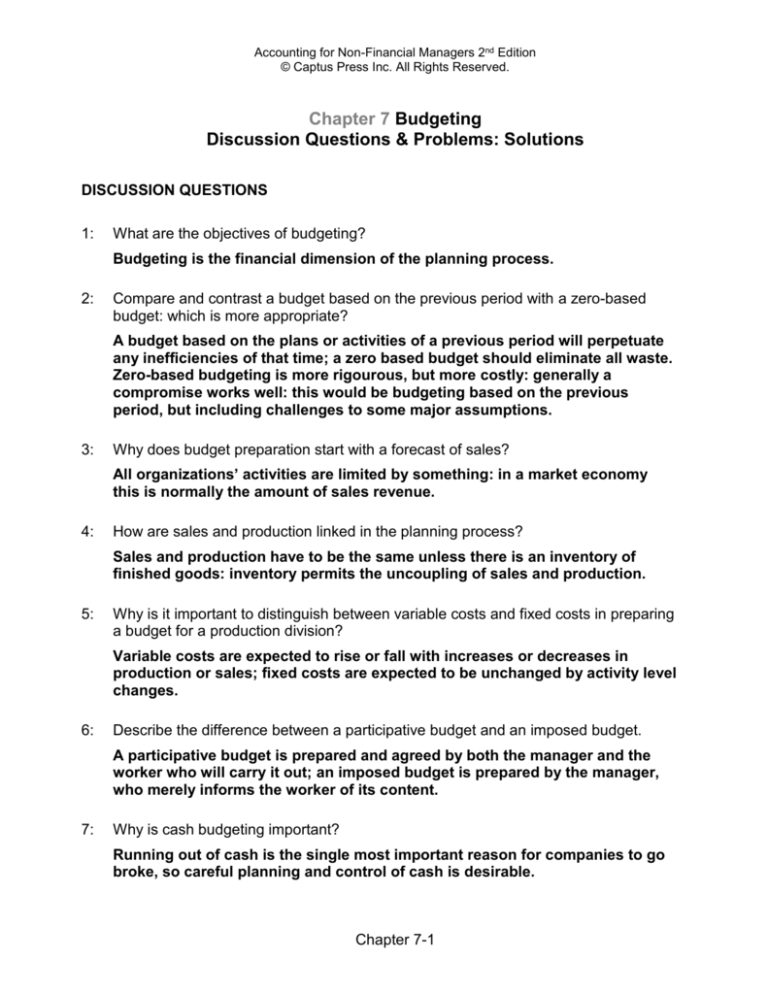
Accounting for Non-Financial Managers 2nd Edition
© Captus Press Inc. All Rights Reserved.
Chapter 7 Budgeting
Discussion Questions & Problems: Solutions
DISCUSSION QUESTIONS
1:
What are the objectives of budgeting?
Budgeting is the financial dimension of the planning process.
2:
Compare and contrast a budget based on the previous period with a zero-based
budget: which is more appropriate?
A budget based on the plans or activities of a previous period will perpetuate
any inefficiencies of that time; a zero based budget should eliminate all waste.
Zero-based budgeting is more rigourous, but more costly: generally a
compromise works well: this would be budgeting based on the previous
period, but including challenges to some major assumptions.
3:
Why does budget preparation start with a forecast of sales?
All organizations’ activities are limited by something: in a market economy
this is normally the amount of sales revenue.
4:
How are sales and production linked in the planning process?
Sales and production have to be the same unless there is an inventory of
finished goods: inventory permits the uncoupling of sales and production.
5:
Why is it important to distinguish between variable costs and fixed costs in preparing
a budget for a production division?
Variable costs are expected to rise or fall with increases or decreases in
production or sales; fixed costs are expected to be unchanged by activity level
changes.
6:
Describe the difference between a participative budget and an imposed budget.
A participative budget is prepared and agreed by both the manager and the
worker who will carry it out; an imposed budget is prepared by the manager,
who merely informs the worker of its content.
7:
Why is cash budgeting important?
Running out of cash is the single most important reason for companies to go
broke, so careful planning and control of cash is desirable.
Chapter 7-1
Accounting for Non-Financial Managers 2nd Edition
© Captus Press Inc. All Rights Reserved.
8:
Who, in the organization, is responsible for forecasting sales quantities and selling
prices?
Could be a number of people, including: top management; marketing
managers, sales managers, outside experts, or even a team of managers.
9:
Who, in the organization, is responsible for preparing the master budget?
While budgets for operating units may be prepared by the managers of those
units, the master budget is always prepared by the management accounting
staff.
10: What are the advantages and disadvantages of selling goods on credit?
Credit sales increase the level of sales; the downside is that they have to be
financed and it exposes the company to the risk of loss from bad debts.
Chapter 7-2
Accounting for Non-Financial Managers 2nd Edition
© Captus Press Inc. All Rights Reserved.
PROBLEMS
7.1
You are given last year’s budget and actual financial report for the internal audit
department at Woodhouse Warehouse:
Details
Budget
Actual
Staff salaries
$600,000
$575,000
Salary-related expense
60,000
57,500
Travel & lodging
200,000
150,000
Equipment-related expense
50,000
50,000
Training
25,000
nil
Total
$935,000
$832,500
The salaries were below budget because of a vacancy in the last quarter of the year:
a new audit employee will be starting work on January 1. Audit staff earned a salary
of $100,000 each in the current year. Next year the salary will be $110,000 (that
includes the new employee). Salary-related expenses (health, pension, etc) are 10%
of salary expense.
Travel and lodging expenses were down because site visits (at 15) were fewer than
planned (the department had planned 20 visits). Next year 25 visits are planned.
Travel and lodging expense is expected to cost 5% more next year. Training was not
carried out as expected this year, but next year a $75,000 training expense is
expected.
Required
(a) Prepare a budget for next year.
Woodhouse Warehouse:
Internal Audit Department:
Budget for next year:
Staff salaries: 6 * $110,000
Salary-related expense
Travel & lodging: 20 * $10,000 + 5%
Equipment-related expense
Training
Total
$ 660,000
66,000
210,000
50,000
75,000
$1,061,000
Chapter 7-3
Accounting for Non-Financial Managers 2nd Edition
© Captus Press Inc. All Rights Reserved.
(b) If you expected that the budget committee would “automatically” cut your
proposed budget by 5%, what should you do?
The budget numbers should be inflated to accommodate the expected 5% cut:
Proposed budget – 5% = $1,061,000
Proposed budget should total $1,116,842
Precisely how that can be done without being discovered is not easy to say.
7.2
AM Inc. makes breakfast cereals at its plant in London, Ontario. Sales of Wheat
Squares for the current year were as follows:
1st quarter
300,000 tonnes
2nd quarter
200,000 tonnes
3rd quarter
240,000 tonnes
4th quarter
360,000 tonnes
Required
(a) Wheat Squares have a short shelf life because some of the ingredients are
perishable, so they cannot be kept more than one month. How much should the
company produce each month? What capacity plant is necessary?
January-March:
April-June:
July-September:
October-December:
100,000 tonnes per month;
66,667 tonnes per month;
80,000 tonnes per month;
120,000 tonnes per month.
Maximum plant capacity = 120,000 tonnes per month
(b) The food lab has developed a recipe based on genetically modified ingredients
so that the shelf life is increased to six months. Now how much should the
company produce each month? What capacity plant is necessary?
Maximum demand is in quarter 4: 360,000
With the longer shelf life product can be made in quarter 3 and sold in quarter
4, plant size would need to be
(240,000 + 360,000)/6 = 100,000 tonnes per month.
Chapter 7-4
Accounting for Non-Financial Managers 2nd Edition
© Captus Press Inc. All Rights Reserved.
7.4
A Co. sold $1,000,000 of self-help books in 2005. The Canada-wide market for selfhelp books was $25,000,000. Next year, due to the entry of a new competitor, the
total market is expected to double in size, but A Co.’s market share will fall by 20%.
Required
Estimate the sales revenue for A Co. for next year.
2005: Total market ($25,000,000) * A Co. market share (4%)
2006: Total market ($25,000,000 *2)
A Co. market share (4% * 80%)
Sales forecast:
= $1,00,000
= $50,000,000
= 3.2%
= $1,562,500
7.5
You are given the sales figures for BC Co. for the past five years:
Year Sales Revenue
1
$10,000,000
2
10,700,000
3
11,500,000
4
12,300,000
5
13,200,000
Required
(a) Calculate the % year-on-year increase in sales.
($10,700 - $10,000)/$10,000 = 7.0%;
($11,500 - $10,700)/$10,700 = 7.5%;
($12,300 - $11,500)/$11,500 = 7.0%;
($13,200 - $12,300)/$12,300 = 7.3%
(b) Use the average % increase to estimate sales for year 6.
(7.0% + 7.5% + 7.0% + 7.3%)/4 = 7.2%
$13,200 + 7.2% = $14,150
(c) What weaknesses are there to basing estimates purely on past data?
The past may not be representative of the future due to changing
circumstances (technology, competition, changing tastes etc).
Chapter 7-5
Accounting for Non-Financial Managers 2nd Edition
© Captus Press Inc. All Rights Reserved.
7.7
Argenti Inc. has accumulated the following information for preparing its annual
budget:
Sales
54,000 units @ $200
Cost of goods sold includes:
Materials
Direct labour
Production overhead
Beginning inventory
Ending inventory
Selling and administrative expense
2 kg @ $5 per kg
4 hours @ $20
4 hours @ $10 per direct labour hour
10,000 units
6,000 units
$2,500,000
Required
(a) Prepare a production budget in units.
Sales:
Add: closing inventory:
Less opening inventory:
Production budget:
Units
54,000
6,000
60,000
10,000
50,000
Chapter 7-6
Accounting for Non-Financial Managers 2nd Edition
© Captus Press Inc. All Rights Reserved.
(b) Calculate the cost of goods manufactured.
Manufacturing cost:
Materials:
2kg * $5 * 50,000
$ 500,000
Labour:
4 hrs * $20 * 50,000
4,000,000
Production overhead:
4 hours * $10 * 50,000 2,000,000
Total manufacturing cost:
$6,500,000
Cost per unit:
(c) Calculate the cost of goods sold.
54,000 * $130:
$
130
$7,020,000
(d) Calculate the budgeted sales.
54,000 * $200:
$10,800,000
(e) Prepare a budgeted income statement for the year.
Sales revenue:
Les: cost of goods sold:
Margin:
Selling and administrative expense
Operating income:
$10,800,000
7,020,000
$ 3,780,000
2,500,000
$ 1,280,000
7.8
Tryon Co. has a cash balance of $50,000 on January 1. Relevant budgeted
information includes the following:
Cash collected from customers
Payments to suppliers
Direct labour expense
Production overhead expense
Selling and administrative expense
January
$950,000
200,000
300,000
250,000
150,000
February
$900,000
300,000
350,000
250,000
150,000
All expenses are paid in the month incurred. The production overhead expense
includes $50,000 of amortization of plant.
Chapter 7-7
Accounting for Non-Financial Managers 2nd Edition
© Captus Press Inc. All Rights Reserved.
Required
(a) Prepare a cash budget for January and February.
January
February
Opening cash balance:
$ 50,000 $ 150,000
Cash collected from customers
950,000
900,000
Available:
$1,000,000 $1,050,000
Payments to suppliers
Direct labour expense
Production overhead expense
Selling and administrative expense
Less amortization:
Total cash payments:
200,000
300,000
300,000
350,000
250,000
250,000
150,000
150,000
(50,000)
(50,000)
$ 850,000 $1,000,000
Ending cash balance:
$ 150,000
$
50,000
(b) Is there a problem? If there is, suggest ways of dealing with it.
There is no problem: cash balance is reasonable for both months.
7.10
Tennant Co. manufactures cleaning materials that are sold to industrial cleaning
companies. It operates five autonomous divisions, each of which operates a
separate plant. Material purchases are managed centrally to get the benefit of bulk
purchase, and labour rates are governed by a centrally negotiated collective
agreement. In November each year Head Office tells each division its budgeted
sales and budgeted costs for the following year. Regular monthly reports are
circulated showing performance against budget, and managers who fail to meet
budget targets are called to Head Office to explain.
Required
(a) Is this a participative budget situation?
No: it is an imposed budget.
(b) Is this budgeting system appropriate for Tennant Co.?
Yes: as most variables are centrally controlled the budget should be centrally
set and managed.
Chapter 7-8

